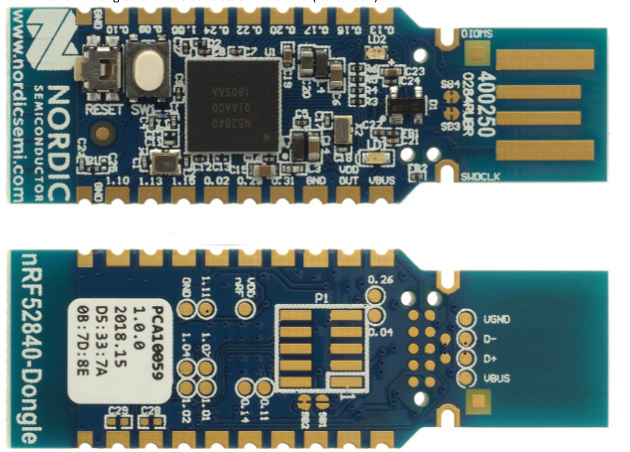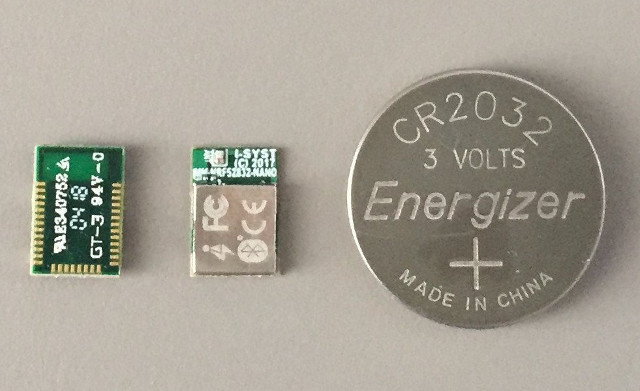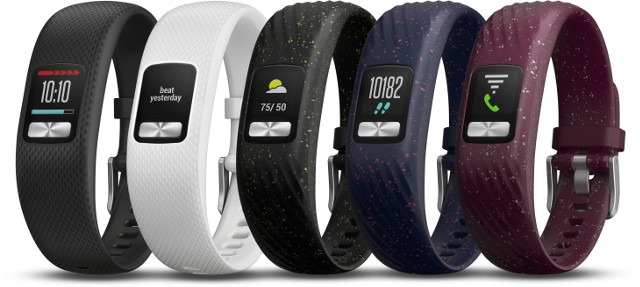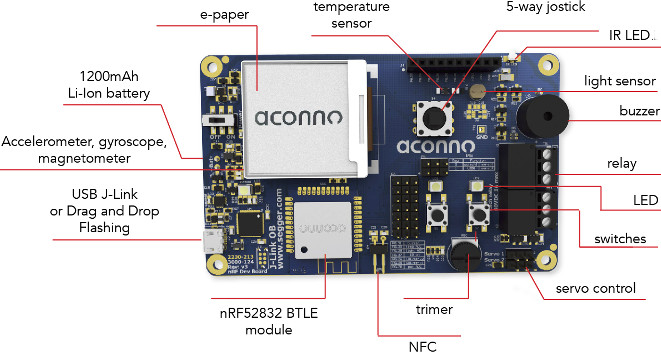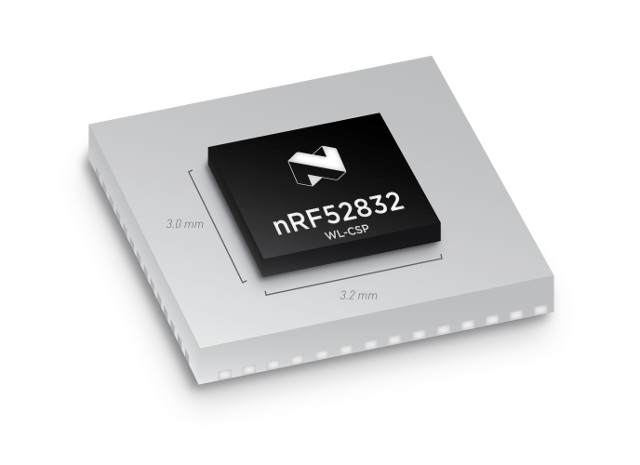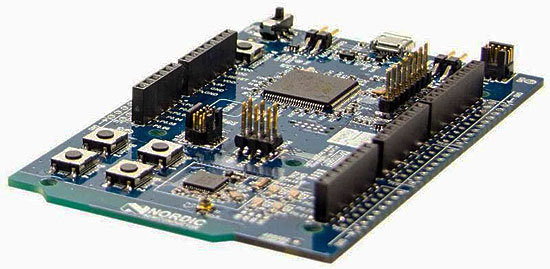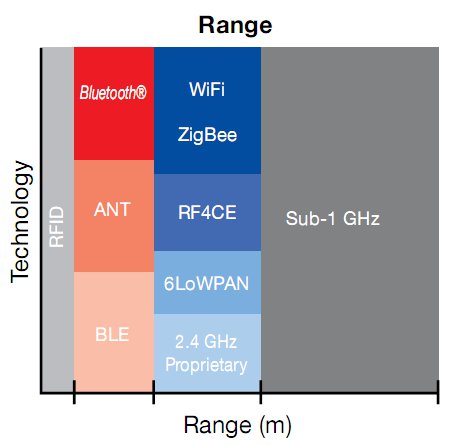Several weeks ago, as I noticed the lack of Bluetooth 5 USB dongles, I found MakerSpot CC2640 Bluetooth 5 USB stick based on Texas Instrument CC2640R2F Arm Cortex-M3 WiSoC. It’s not exactly a consumer products, and instead it’s more like a development kit, but it can still be inserted into the USB port of your computer or development board. Today, I found out Nordic Semi also made their own Bluetooth 5 – or is it Bluetooth 5.0 now, I’m really confused at this point – USB dongle for evaluation & development based on nRF52840 WiSoC. It’s not only for Bluetooth 5 though, as the multi-protocol SoC also supports Bluetooth Low Energy, Bluetooth Mesh, Thread, Zigbee, 802.15.4, ANT(+), and 2.4 GHz proprietary solutions. nRF52840 USB dongle (PCA10059) key features: Wireless Connectivity – Bluetooth 5, Bluetooth Low Energy, Thread, Zigbee, 802.15.4, ANT/ANT+, and 2.4GHz USB – USB 2.0 ports Expansion – 15x […]
IMM-NRF52832-NANO is an Ultra Small nRF52832 Module with Bluetooth 5, ANT+, 30 I/Os
If you have a project requiring a programmable Bluetooth 4.x/5 module that’s as small as possible, Canada based I-Syst may have what you need with their IMM-NRF52832-NANO module measuring just 10 x 7 x 1.6 mm. The module is based on Nordic Semi nRF52832 Arm Cortex-M4F SoC with Bluetooth 5 LE (no long range support) and ANT+ connectivity, and exposes up to 30 I/Os for your project. Specifications: SoC – Nordic Semi nRF52832 32 bits Arm Cortex-M4F @ 64MHz with 512KB Flash, 64KB SRAM, 2.4GHz multi-protocol transceiver Connectivity – Bluetooth 5 LE, ANT+, Type 2 NFC -A Tag with wakeup on field Up to 30x I/Os: 3x SPI Master/Slave 2x 2-wire Master (I2C compatible) UART (CTS/RTS) 3x 4 channel PWM 8x configurable 12 bits, 200 ksps ADC Digital microphone interface Quadrature decoder input Sensors – Temperature sensor Security – AES HW encryption Misc – 32MHz & 32.768KHz crystals, low power […]
Garmin Launches Vivofit 4 Activity Tracker with One Year Battery Life
I have not spent much time covering wearables like smartwatches and fitness trackers this year, mostly because I find they have too many flaws at this stage. Back in 2016, I found many had a short life time, they would just stop working after a few weeks or months, even the fairly popular Xiaomi Mi Band 2 only lasted 2 months after an ill-fated firmware upgrade. In my case, I also found activity / fitness trackers did not have the motivating factor I thought they’d have, so I don’t think I exercise more or less with one. Finally, another annoyance is that most need to be charged every couple of days or weeks, and I’m frequently leaving the one I’m still using (SH09) run out of battery, losing recent data. The best solution to address the latter issue would be some type of energy harvesting, so that we would never […]
Aconno Bluetooth 4.0 & 5 IoT Development Board Features an nRF52832 or nRF52840 Module, an e-Paper Display, Sensors and More
Bluetooth 5 is the latest iteration of Bluetooth with up to four times the speed and twice the range of Bluetooth 4.0 LE, and so far apart from Puck.js and Nordic Semi nRF52840 devkit, I had not seen many Bluetooth 5 IoT modules or boards. Aconno, a German startup, has designed ACD-52832 Bluetooth 4.0 / Thread / ANT+ IoT development board based on their own nRF52832 module, and equipped with some goodies like a black & white e-Paper display, a joystick, sensors, I/Os, etc… They’ve also launched an updated module with Bluetooth 5 using nFR52840 SoC. I don’t have the full details about the new module, but the nRF52832 module and devkit is interesting to look at, especially features should be similar. Aconno ACD-52832 board specifications: Wireless Module – ACN52832 based on Nordic Semi nRF52832 ARM Cortex-M4 @ 64 MHz SoC with Bluetooth Smart, ANT+, Thread, NFC, and 2.4 GHz […]
Nordic Semiconductor nRF52832 Cortex-M4 ANT & Bluetooth LE SoC Gets Even Tinier
Nordic Semiconductor nRF52832 is a Bluetooth 4.2 LE SoC based on an ARM Cortex-M4F core that was first released about a year ago in a QFN48 package targeting IoT and Wearables. But if your application is really tight on space and the 6x6mm package is just too big, the company has just introduced a 3.0×3.2mm WL-CSP (Wafer Level Chip Scale Package ) package for nRF52832 decreasing the area to about one quarter of the QFN package The specifications are exactly the same as the QFN, but let’s see what we’ve got in that 9.6mm2 package: MCU Core – ARM Cortex-M4F @ 64 MHz with DSP & FPU, 512kB Flash and 64kB RAM 2.4 GHz radio for ANT, Bluetooth 4.2 LE, and Gazell connectivity; 5.5mA peak RX/TX currents; on-chip RF Balun On-chip NFC tag Peripherals – 3x Master/Slave SPI, 2x Two-wire interface (I²C), UART (RTS/CTS), 3x PWM, Digital microphone interface (PDM) Security […]
Nordic Semi Announces nRF51 DK Arduino Compatible Board, and nRF51 Dongle with Bluetooth Smart, ANT, and 2.4GHz Connectivity
Nordic Semiconductor has introduced two new low cost development boards supporting Bluetooh LE, ANT/ANT+, and proprietary 2.4GHz applications based on their nRF51 series SoCs: nRF51 DK, an Arduino UNO Rev.3 compatible board that can be used for various IoT and wearables applications, and nRF51 Dongle, a USB dongle to connect to a PC or board, which can be useful for packet sniffing and BLE peer connection. nRF51 DK Development Board Key features listed for the board: SoC – Supports nRF51822 (BT/2.4Ghz) and nRF51422 (BT/ANT) SoCs based on an ARM Cortex M0 processor, with 128kB or 256kB flash memory, and 16kB or 32kB RAM. Connectivity Bluetooth Smart, ANT/ANT+ and 2.4GHz proprietary Integrated PCB antenna Connector for RF measurements Expansions Headers Arduino Uno Rev. 3 compatible connector for use with 3rd party shields All I/O and interfaces available via connectors Debugging Segger J-Link OB and ARM CMSIS-DAP Program/Debug supported Support for Program/Debug […]
List of Wireless Standards for Local and Personal Area Networks
While designing your embedded system, you may have to choose between different wireless standards to match your needs. I’ll provide a list a short and mid-range wireless standards, their description and links to open source software stacks (when available) to help you better understand the different options available. Wide Area Network wireless network such as LTE, Wimax, etc.. won’t be discussed in this blog entry. Mesh and IP Networks: Wifi (IEEE 802.11): Wifi is probably the most used wireless standard in consumer electronics devices today as it allows users to connect their device to their LAN wirelessly. An access point has a typical range of about 20 meters indoors and up to 100m outdoors. There are 4 standards 802.11a 802.11b, 802.11g and 802.11n. The latest has a theoretical throughput of 300 Mbps. Check out Wikipedia Wifi page for details. The Wi-Fi stack is part of the Linux kernel but you […]


